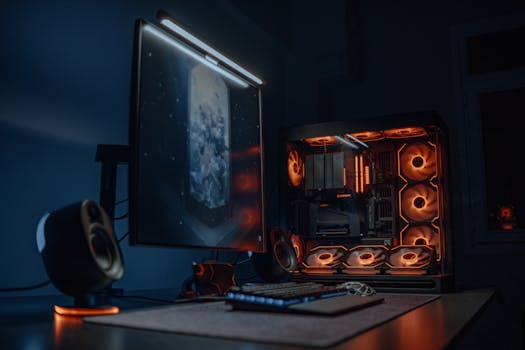Beyond the Bling: Demystifying PC Fan RGB for Performance and Panache

Let’s be honest. When you first heard about “PC fan RGB,” your mind probably conjured images of a disco ball trapped inside your computer case. And who can blame you? For a while there, it seemed like every component under the sun was plastered with flashing lights. But beneath the vibrant spectacle lies a more nuanced reality. PC fan RGB isn’t just about making your rig look like a cyberpunk art installation; it can also be a subtle nod to your PC’s performance, a way to personalize your build, and frankly, just a lot of fun. So, let’s peel back the rainbow and see what makes these luminous spinners tick.
Why So Many Colors? The Evolution of PC Cooling Aesthetics
Remember the days of the utilitarian beige box? Computers were designed for function, and cooling solutions were purely about thermodynamics, not aesthetics. The humble PC fan was a noisy, often uninspiring piece of plastic whose sole purpose was to shove air around. Then, something magical (or perhaps, slightly over-the-top) happened. Manufacturers realized that users wanted their machines to reflect their personality. This, coupled with advancements in LED technology, gave birth to the pc fan rgb phenomenon. What started as simple single-color LEDs evolved into sophisticated systems capable of displaying millions of hues, intricate patterns, and synchronized light shows. It’s a testament to how far PC customization has come, allowing us to treat our rigs as canvases.
Performance Under the Prismatic Glow: Does RGB Affect Cooling?
This is where the serious gamers and enthusiasts often raise an eyebrow. “Does all that fancy lighting actually impact my CPU temperatures?” It’s a valid question! In most cases, the RGB lighting itself has a negligible impact on cooling performance. The LEDs draw a tiny amount of power, and the heat generated by them is minimal compared to the heat output of your CPU or GPU.
However, there’s a subtle connection. High-quality RGB fans often go hand-in-hand with better overall fan design. Manufacturers investing in intricate RGB circuitry are usually also focused on blade aerodynamics, bearing quality, and quiet operation. So, while the lights aren’t cooling your components, the fans that happen to have RGB might be superior performers. It’s like buying a sports car with racing stripes – the stripes themselves don’t make it faster, but the car they’re on likely is.
The Art of Illumination: Choosing Your RGB Flavor
When you dive into the world of pc fan rgb, you’ll encounter a few different technologies:
Single Color LEDs: The OG. Simple, effective, and usually the most budget-friendly. Great if you want a consistent, understated look.
Addressable RGB (ARGB): This is where the magic happens. Each LED on the fan can be individually controlled. This allows for dynamic effects like flowing colors, breathing patterns, and complex animations. It’s the most versatile option for creating truly personalized lighting.
Proprietary RGB Systems: Many manufacturers have their own ecosystems (e.g., Corsair iCUE, ASUS Aura Sync, MSI Mystic Light). These often offer deeper integration with other components and more advanced software control, but can lock you into their brand.
Choosing the right type often depends on your motherboard’s capabilities and your desired level of control. If your motherboard has ARGB headers, you’re golden for most modern, addressable RGB fans.
Beyond the Case: Syncing Your PC’s Inner Light Show
One of the most compelling aspects of modern pc fan rgb is synchronization. No one wants a PC where the CPU cooler is pulsing blue while the case fans are stuck on red. Thankfully, most systems allow you to synchronize your RGB lighting across various components. This can be achieved through:
Motherboard Software: As mentioned, if your motherboard supports Aura Sync, Mystic Light, or similar, you can often control a wide range of RGB devices.
Dedicated Controllers: Some fan kits come with their own RGB controllers. These can be a great option if your motherboard lacks sufficient RGB headers or you want more granular control.
Third-Party Software: A few universal RGB control programs exist, though compatibility can sometimes be hit or miss.
The goal is a cohesive, harmonious visual experience. Imagine your PC booting up with a gentle wave of color, your GPU fans mirroring the theme, and your RAM modules adding a subtle glow. It’s the ultimate expression of digital artistry.
Practical Considerations: More Than Just Pretty Lights
While the aesthetic appeal of pc fan rgb is undeniable, there are practical aspects to consider:
Software Complexity: Advanced RGB control software can sometimes be a bit daunting for newcomers. Be prepared to spend a little time learning the ropes.
Cable Management: More RGB fans often mean more cables (power and RGB data). Good cable management becomes even more crucial to avoid a spaghetti monster lurking inside your case.
Power Draw: While minimal, a large number of RGB fans can add a slight extra load on your motherboard’s USB headers or dedicated fan controller.
Cost: RGB fans are generally more expensive than their non-RGB counterparts.
However, for many, the added cost and slight complexity are well worth it for the customization and visual flair they bring to their rig. It’s about building a machine that feels truly yours.
Wrapping Up: Is Your PC Ready for Its Close-Up?
So, there you have it. PC fan RGB is far more than just a fleeting trend; it’s an integral part of modern PC customization. It allows you to inject personality into your build, create stunning visual displays, and, in many cases, enjoy excellent cooling performance. Whether you’re a hardcore gamer aiming for that perfect aesthetic or a creative professional wanting a more inspiring workspace, the world of pc fan rgb offers a spectrum of possibilities.
Now, the real question is: are you ready to let your PC shine, or are you still content with a dimly lit existence?




 How Much Does It Cost to Hire Angular Developers in 2026?
How Much Does It Cost to Hire Angular Developers in 2026?  How to Download Instagram Videos and Photos Easily
How to Download Instagram Videos and Photos Easily  Navigating Gestational Diabetes: Your Phone as Your New Best Friend
Navigating Gestational Diabetes: Your Phone as Your New Best Friend  Unleash Your Inner Gamer: Navigating the Wild West of Gaming PC Stores in Las Vegas
Unleash Your Inner Gamer: Navigating the Wild West of Gaming PC Stores in Las Vegas  How to Choose the Perfect New Home in the Houston Area
How to Choose the Perfect New Home in the Houston Area  First-Timer’s Guide to Visiting a Dispensary: What to Expect
First-Timer’s Guide to Visiting a Dispensary: What to Expect  Practical Tips for Building a Strong Hybrid Work Culture in Your Company
Practical Tips for Building a Strong Hybrid Work Culture in Your Company 